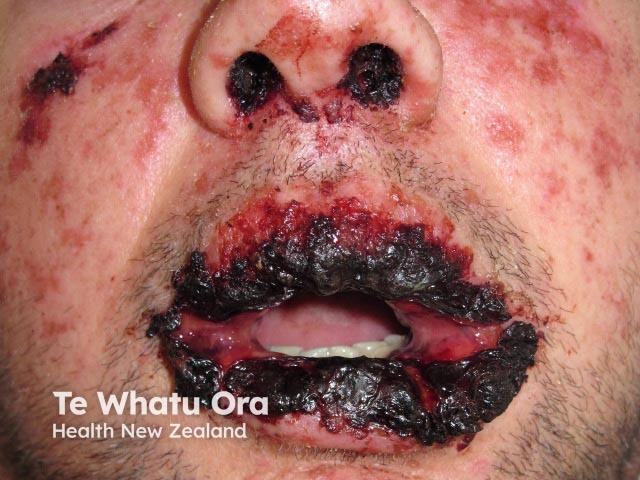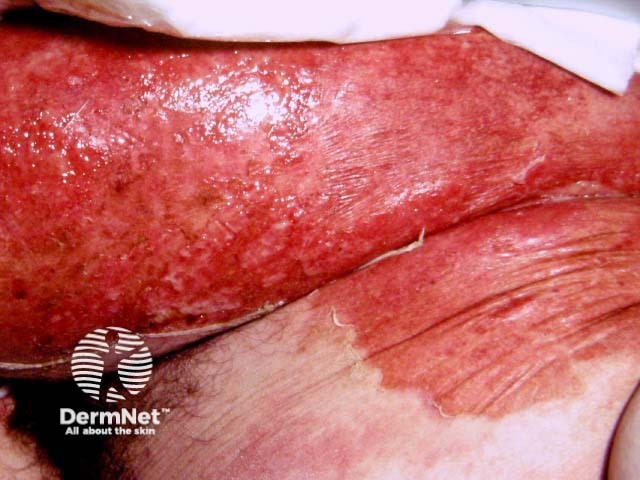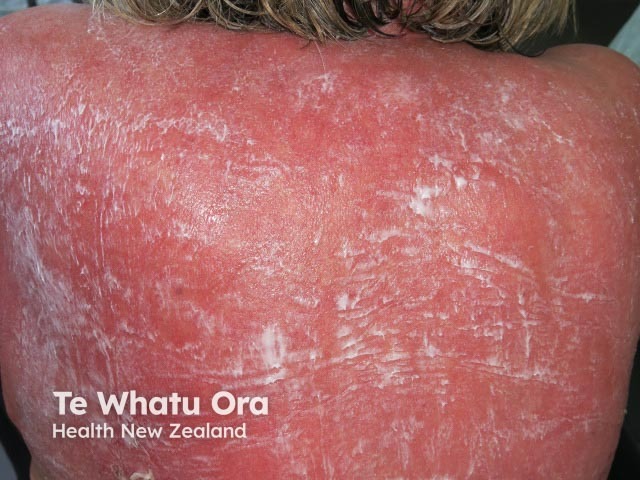Main menu
Common skin conditions

NEWS
Join DermNet PRO
Read more
Quick links
Authors: Dr Elise Ouedraogo, Dermatology Registrar, Faculte Paris VI, Paris, France; Prof Olivier Chosidow, Dermatologist, Creteil, Paris XII, France; Prof Christian Brun-Buisson, Intensive care, Creteil, Paris XII, France; Prof Armand Mekontso–Dessap Armand, Intensive care, Creteil, Paris XII, France; Dr Christopher Mansell, Microbiologist, Hamilton New Zealand; Dr De Prost Nicolas, Intensive care, Creteil, Paris XII, France; Dr Oro Saskia, Dermatologist, Creteil, Paris XII, France. DermNet Editor-in-Chief: A/Prof Amanda Oakley, Dermatologist, Hamilton, New Zealand. January 2018.
Introduction Demographics Benefits SCORTEN criteria Patient precautions Equipment required Role of health provider Bacteria mapping Intravenous access Pain control Oral feeding
Stevens Johnson syndrome /toxic epidermal necrolysis (SJS/TEN) is a very severe and acute skin disease, almost always caused by a drug.
SJS/TEN is characterised by an extensive necrosis and detachment of the epidermis, which involves skin and mucosal surfaces (genitals, eyes, and mouth).
The nursing care described on this page is adapted from the Créteil protocol for patients with toxic epidermal necrolysis [1].

Mucosal involvement

Epidermal necrolysis

Cream applied to red skin
This protocol is recommended for all health care providers caring for patients with SJS/TEN or similar skin conditions especially severe cutaneous adverse reactions to drugs.
Suitable nursing care can reduce the mortality and adverse sequelae of SJS/TEN, especially when a large area of skin / mucosa is affected and intensive care is needed. Expert nursing care should commence as soon as the patient has arrived at the hospital and continue until discharge. The patient should be cared for in bed until well enough to ambulate safely.
The benefits of this protocol are:
The prognosis of SJS/TEN should be determined during the first 24 hours. SCORTEN is an illness severity score that has been developed to predict mortality in SJS/TEN. One point is scored for each of seven criteria present at the time of admission. The SCORTEN criteria are:
The risk of dying from SJS/TEN depends on the score. Depending on local protocols, if SCORTEN is more than 1, the patient is managed in intensive care, a burns unit or a specialist dermatology unit of a regional hospital.
Use the Wallace rule of 9 to estimate the affected body surface area.
Percentages of the total body surface area for an adult or child over 10 years
Percentages of the total body surface area for a child under the age of 1
Over 1 year and below 10 years, the percentage of body surface area changes
Determine any prior history of adverse reaction to antibiotics and antiseptics, as these may be required to manage infection.
The SJS/TEN patient should be managed in a single room. Requirements include:
Personal protective equipment for healthcare providers should include:
Patient eye care requirements:
Patient mouth care requirements:
Patient genital care requirements:
Patient skin care requirements:
Bacteria mapping requirements:
Intravenous fluid requirements:
The health care provider should keep the patient's room clean and warm, and gently but thoroughly cleanse and protect the skin, mouth, eyes and genitals.
Maintain environmental temperature
Maintain hygiene
Eye care
Mouth care
Genital care in females
Genital care in males
There must be more at least two health providers.
Bathing
If a bath is contraindicated or unavailable, perform a gentle bed-bath using aqueous cream, warm water and a soft cloth.
During the bath
After the bath
Bacteria mapping takes place twice a week BEFORE the patient takes a bath. Two people are needed. Choose three different areas more likely to be infected (eg, axilla, groin, eroded skin). A patient label is applied to each agar plate with date, time, and body site number.
Insert a central catheter for IV fluids. Follow these precautions:
Fluid requirements
Evaluate the patient’s pain before, during and after care.
Written notes should report every care on the patient record and record pain on a monitoring sheet.